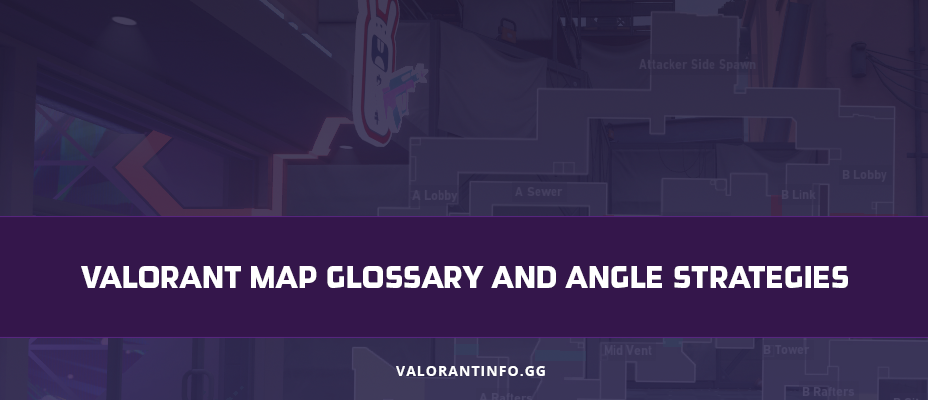Valorant maps have many terms in common, which players should familiarize themselves with to make effective callouts to their teammates. The following Valorant map glossary will help players learn many of the generic terms around the Valorant maps.
Players should also take the time to open each full-size Valorant map and learn the specific terms and callouts for sections of the maps, such as “Hookah,” “Arcade,” and more. Learning locations around the map along with coordinating strategies will help players level up, along with creating better communication with teammates.
Valorant Map Glossary Terms
- Angles – A corner area of a map. A player moving past this angle must put themselves in danger to get past it. See “clearing angles.”
- Angle Advantage – The player further away from an angle has an advantage on that angle due to the player model becoming visible as the player holding an angle peeks.
- Back/Back Site – The part of the spike site closest to the defender spawn.
- Bomb – Another term for the spike.
- Callout – When a player refers to a specific place on the map by name with information about the enemy. Example: “Cypher is half in Elbow.”
- Clearing Angles – A player needs to work with the team to clear potentially dangerous angles while moving through an area, checking for the enemy players.
- Clearing Site – Refers to clearing all angles around the spike site to safely plant, removing the danger of hidden enemy players that could ambush while planting.
- CT – Counterterrorist, a holdover from Counter-Strike players, typically used for defender side spawn areas.
- Cubby – A part of the map that has a deep recess where players can hold and surprise the enemy.
- Default – The typical strategy and plant area for any given site or map. Each site on each map has a “default” planting spot, and this information is good to learn, especially if a player mains an agent with “lineups.”
- Elbow – A tight location in a map that contains two or three 90 degree angles.
- Flank – When a player sneaks around to the enemy side of the map to catch the enemy off guard from behind.
- Heaven – Any higher levels of Valorant maps, often used by snipers.
- Hell – The area directly underneath heaven locations.
- Holding Angles – Watching a specific map angle with good crosshair placement in anticipation of an enemy peeking.
- Lineups – Using details on the map to fire agent abilities from long distances, often to prevent spike plant or defuse.
- Link – A short passageway on a map that connects two larger areas together.
- Long – Refers to long alleyways and entrances to spike sites, often held by snipers.
- Lurk – To hang around in areas where the enemy might pass through or retreat to on the map, typically on offense.
- Main – The entrance most often used to enter a site.
- Mid – The areas between sites on a map.
- Off-Angle – Holding an unusual or unexpected angle in hopes of catching an enemy off guard.
- One-Way – A smoke that allows the player to see the enemy first but blocks the enemy’s view of the player. It can also be done with some other abilities such as Sage wall or Cypher cage.
- Peeker’s Advantage – The player that aggressively peeks usually has an advantage of seeing an enemy first due to technical lag time in the game.
- Retake – Refers to taking back a site after the enemy has captured it.
- Short – A short passageway from the attacker’s side towards the spike site.
- Site – Short for “spike site,” refers to the area where the spike can be planted.
- Spawn – Refers to where the team or enemy begins each round.
- Spike – The objective for every round is to plant or defuse this bomb from one of the map’s spike sites.
- TP – Short for the teleporter on Bind; can also refer to Omen’s teleport ability.
- Wallbang – Refers to shooting an enemy through walls.
Basic Angle Strategy in Valorant
Holding angles is vital across all maps in Valorant, and knowing common angles and strategies can make the difference between winning and losing.
Take the time to learn common entry points for each map and the angles players can hold to get the best vantage points on the enemy. Also, ensure that crosshair placement is good to get the picks as enemies cross those angles.
Off-angles can also be important. Taking a position at an angle where an enemy might not expect or even clear can catch an enemy off guard.
Finally, remember two scenarios where a player has an advantage in an angle: peeker’s advantage and the angle advantage of holding further back. With peeker’s advantage, any player that aggressively peeks an angle will almost always have the advantage due to technical lag in the game.
Holding an angle further back also gives an advantage due to seeing the enemy character model first. It can be beneficial to a position further away from an angle. These are just some of the most basic strategies for Valorant maps.
Using the Valorant map glossary terms, learning the maps, locations, callouts and angles will help level up your overall gameplay and provide you with the competitive edge you’ll need to win.
